Vida Milovanovic looks at how the Royal Society set up a committee in 1883 ‘to collect the various accounts of the volcanic eruption at Krakatoa ... in such form as shall best provide for their preservation and promote their usefulness.’

One of the most violent volcanic eruptions ever observed announced itself with the loudest explosion in recorded history. Ushering in earthquakes, tsunamis and unusual weather events, the effects were felt across the globe. In my role as Archive Cataloguer, I’ve been adding to our online records and looking at how the Royal Society gathered data on the eruption and its after-effects.
In 1883 Krakatoa (Letusan Krakatau), a volcano on Rakata Island in the Sunda Strait between the Indonesian Islands of Java and Sumatra, erupted. The event peaked on 27 August with catastrophic effects resulting in 36,000 deaths and the destruction of 70% of the island of Krakatoa, with its surrounding archipelago collapsing into the caldera.
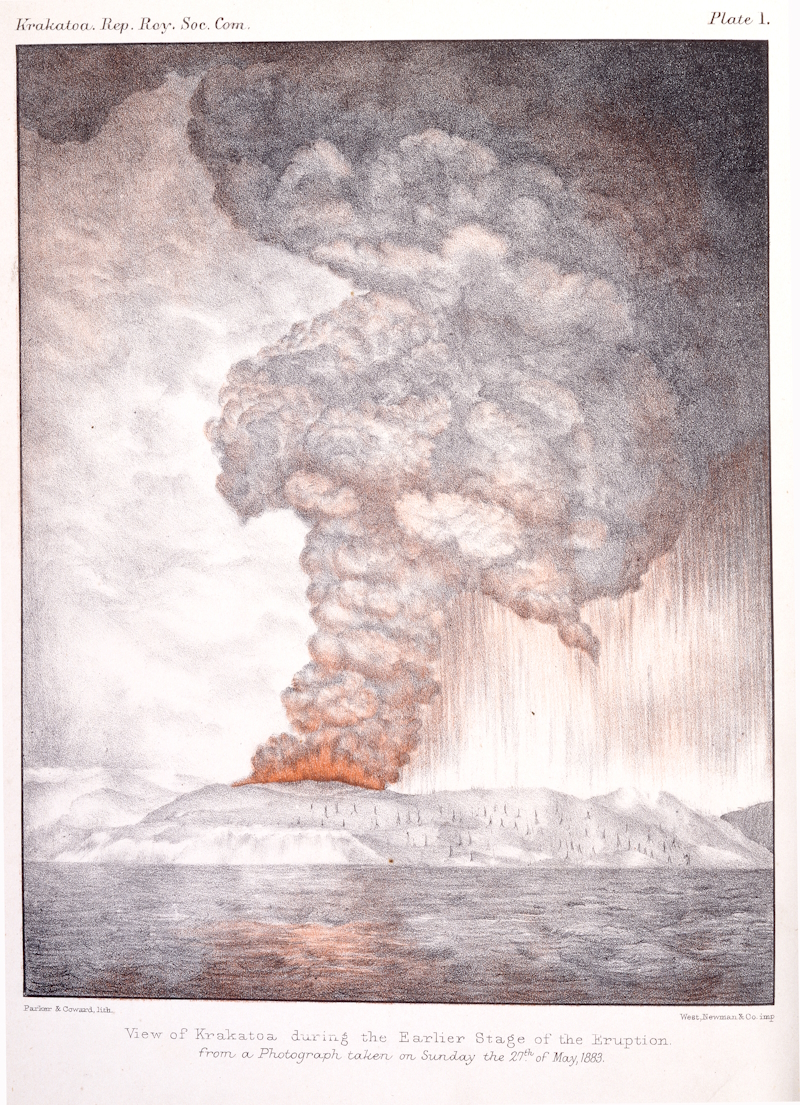 View of Krakatoa during the earlier stage of the eruption, from a photograph taken on Sunday, 27 May 1883, published in the Report of the Krakatoa Committee of the Royal Society.
View of Krakatoa during the earlier stage of the eruption, from a photograph taken on Sunday, 27 May 1883, published in the Report of the Krakatoa Committee of the Royal Society.
Council of the Royal Society formed a special committee ‘to collect the various accounts of the volcanic eruption at Krakatoa, and attendant phenomena, in such form as shall best provide for their preservation and promote their usefulness.’ In Nature volume 29 (1884), the Krakatoa Committee invited ‘the communication of authenticated facts respecting the fall of pumice and of dust ... observation of unusual disturbances of barometric pressure and of sea-level, the presence of sulphurous vapours, the distances at which the explosions were heard, and exceptional effects of light and colour in the atmosphere.’
This endeavour to collate accurate witness statements and detailed accounts of the event and its aftermath is not unlike modern methods of crowdsourcing. Prior to 1883, natural philosophers had struggled to understand volcanoes, and Krakatoa incentivised them to discover more. In response to the advertisement, numerous letters and even pumice specimens were received by the Royal Society from around the world. The letters offer detailed descriptions of subsequent phenomena, including exact coordinates of the location from which they were observed. They make for fascinating reading for scientists and non-scientists alike.
The eruption of Krakatoa expelled approximately 21 cubic kilometres of rock fragments into the atmosphere, with ash covering an expanse of around 800,000 square kilometres. Nearer the volcano, the presence of densely packed floating pumice impeded the progress of ships. The adjacent area experienced a blackout lasting two and a half days due to the airborne ash.
An excerpt from the log of the ship Earl Beaconsfield, Calcutta, 23 September 1883, describes a fair passage from England, until the crew woke up one morning to find everything smothered in lava, with pumice floating in the sea. The incident continued for four days and the dust was impossible to remove. At the time, the ship was 900 miles away from the nearest volcano (in Sumatra), and upon arrival in Calcutta (Kolkata), they heard news of earthquakes there.
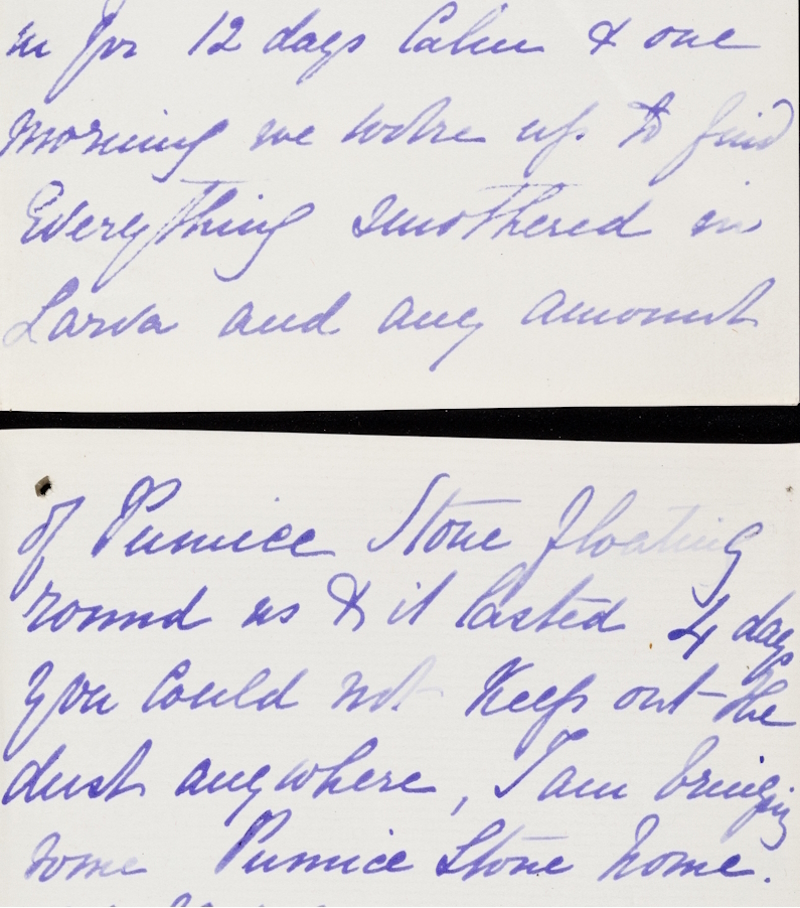 Letter from the Earl Beaconsfield to the Royal Society Krakatoa Committee (MS/516/6, letter 4)
Letter from the Earl Beaconsfield to the Royal Society Krakatoa Committee (MS/516/6, letter 4)
Other letters from the Bay of Bengal corroborate this observation. Captain Charles Reeves, on board the barque Umvoti, noted distinct varieties of pumice, some covered in barnacles and marine growth, leading him to the conclusion that there must have been several explosions spread over time.
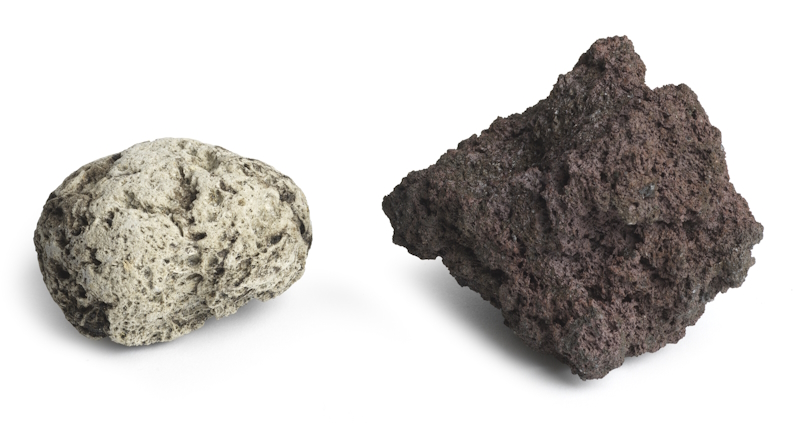 A sample of pumice (left) from the 1883 eruption of Krakatoa and a sample of lava (right) extruded from Anak Krakatau ('Child of Krakatoa') in 2012 (RS.14177)
A sample of pumice (left) from the 1883 eruption of Krakatoa and a sample of lava (right) extruded from Anak Krakatau ('Child of Krakatoa') in 2012 (RS.14177)
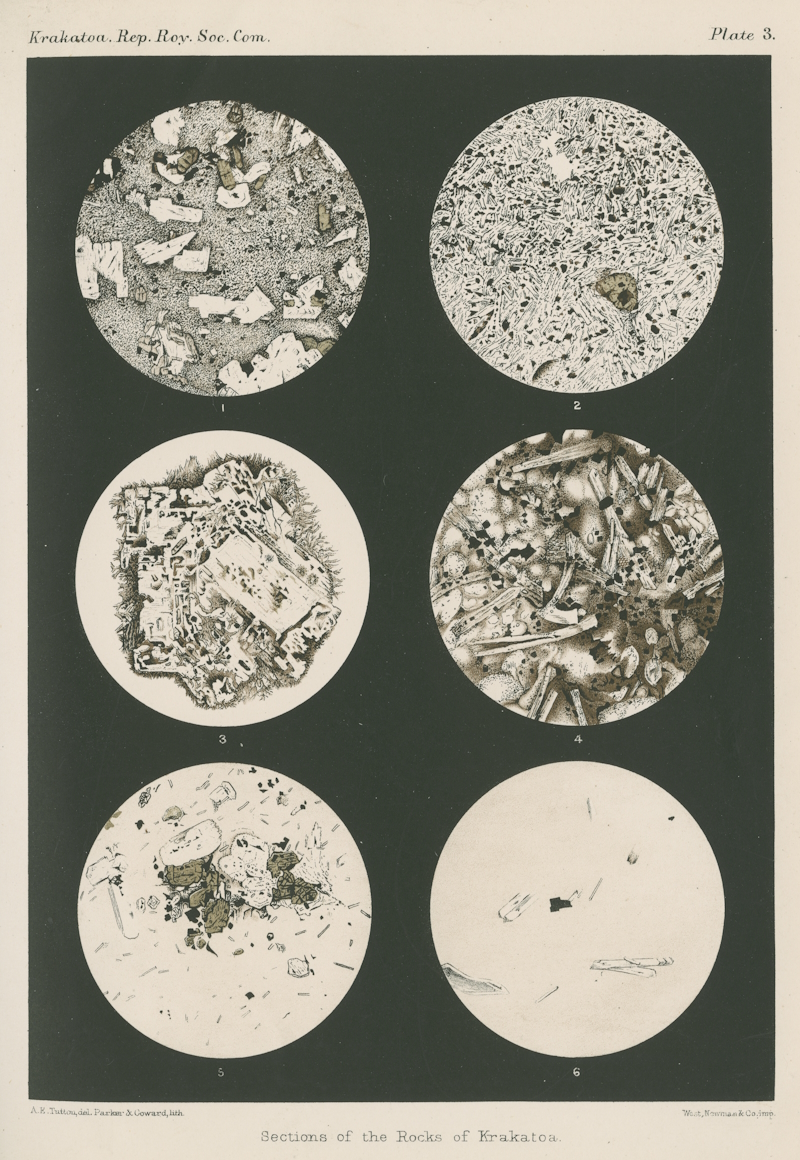 Sections of Krakatoa lavas at x25, x35 and x250 magnifications, 1888, broken down into 6 separate figures (RS.10672)
Sections of Krakatoa lavas at x25, x35 and x250 magnifications, 1888, broken down into 6 separate figures (RS.10672)
In the year following the eruption, the fine dust drifting multiple times around the Earth caused spectacular red and orange sunsets:
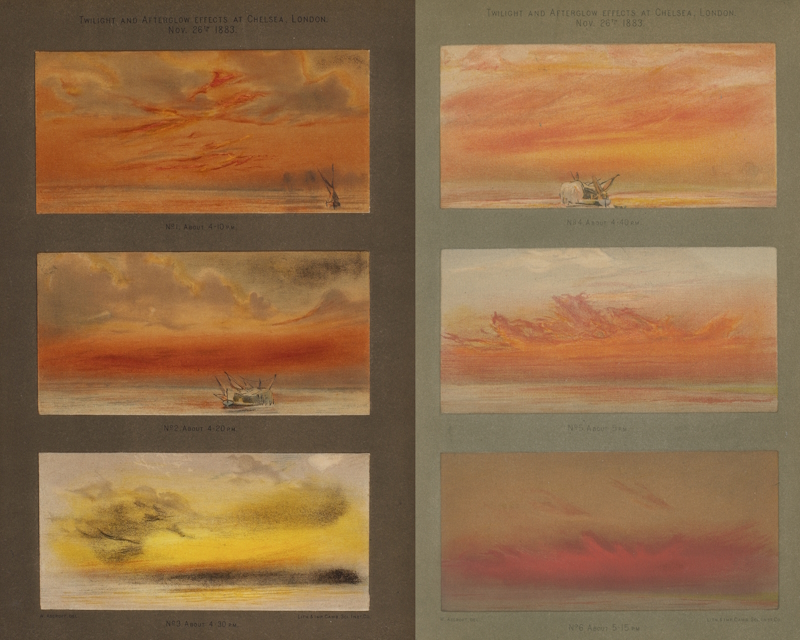 Figures of sunset effects caused by the eruption of Krakatoa. These landscape scenes were observed and painted by William Ascroft (1832–1914), on 26 November 1883 at Chelsea, England. Published in the Report of the Krakatoa Committee of the Royal Society (RS.10668 and RS.10669)
Figures of sunset effects caused by the eruption of Krakatoa. These landscape scenes were observed and painted by William Ascroft (1832–1914), on 26 November 1883 at Chelsea, England. Published in the Report of the Krakatoa Committee of the Royal Society (RS.10668 and RS.10669)
Correspondents in Great Britain, nearly 12,000 kilometres away from Krakatoa, described the vivid atmospheric effects. Charles Brook, writing from Meltham, West Yorkshire, on 29 November 1883, remarked on the ‘peculiar glow surrounding the sun’, describing the colour as moving from a pearly white light to ‘orange and orange-pink to the outside’, akin to ‘when there is a large fire in the neighbourhood’. A Reverend gentleman from Hertfordshire likened the sunset to the aurora borealis whilst John Dundas of Newton Bank, St Andrews, declared a December 1883 sunset ‘the finest I ever saw in my life’.
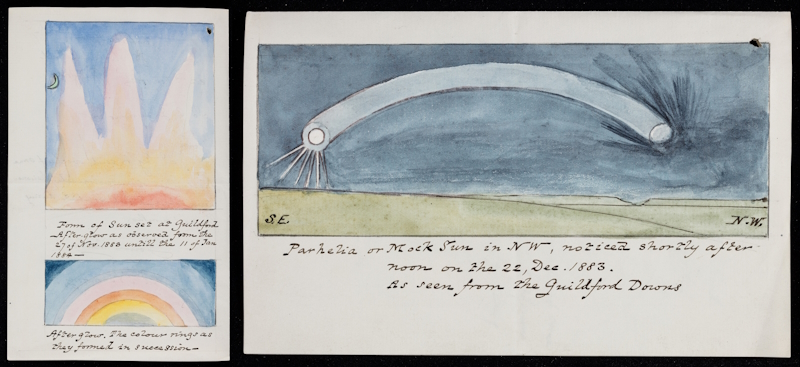
Three figures of atmospheric observations made at Guildford in Surrey, England from November 1883 to January 1884, by Archibald Henry Swinton (MS/516/1, letter 1)
In 2017 scientists suggested that the colourful and wavy nature of the sky depicted in The Scream by Edvard Munch may have been inspired by nacreous ‘mother of pearl’ clouds, observable in Norway at the time and caused by airborne debris from the eruption. Whilst it is most likely that a combination of atmospheric conditions and artistic interpretation resulted in this dramatic depiction of the sky, it is fascinating to contemplate the far-reaching nature of the event.
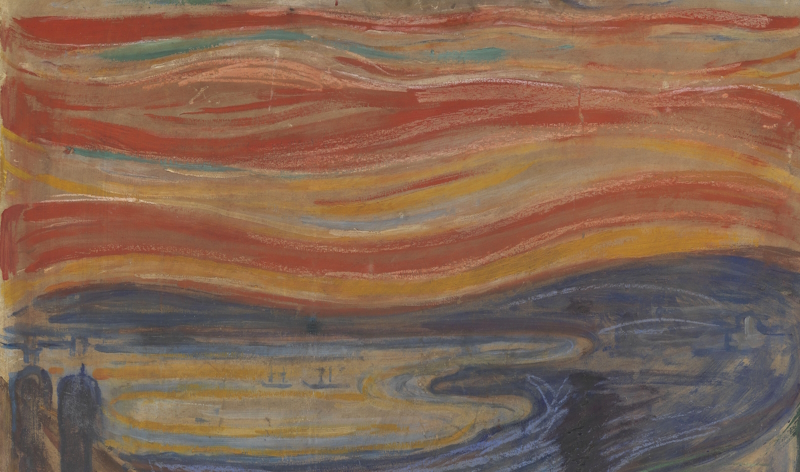
Close up detail of the sky in The Scream: public domain, via Wikimedia Commons
The Hydrographer of the Admiralty on board HMS Magpie, Penang, writing on 20 January 1884, recalled hearing sounds of detonation in the Sunda Strait. He observed unsettled weather, thick and hazy, with the barometer noticeably affected. Other correspondents stated that they heard loud sounds they could not explain, ascribing them to cannons or gunshots.
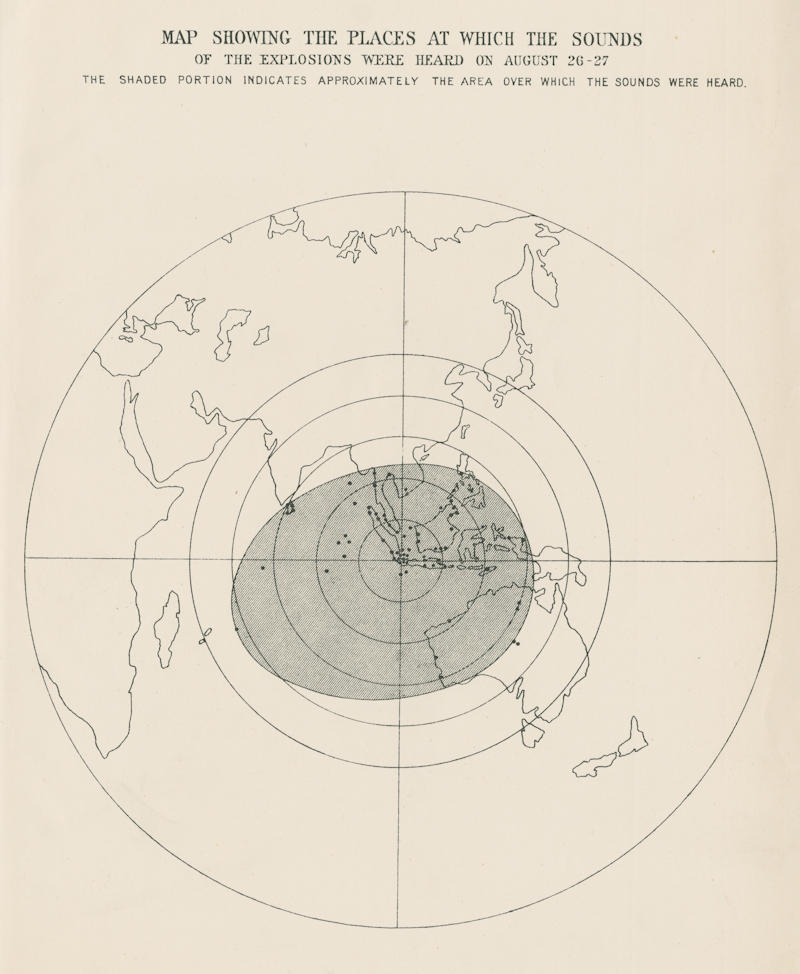 Map showing the geographical range of humans hearing the Krakatoa explosions, published in the Report of the Krakatoa Committee of the Royal Society
Map showing the geographical range of humans hearing the Krakatoa explosions, published in the Report of the Krakatoa Committee of the Royal Society
The colossal third explosion of Krakatoa produced a pressure wave with an estimated sound intensity of 180dB, audible up to 5,000 kilometres away. This ruptured the eardrums of sailors aboard the RMS Norham Castle off Sumatra and caused a gasometer in the Batavia gasworks, 160 km away, to register a spike of over 8.5 kilopascals, surpassing the scale.
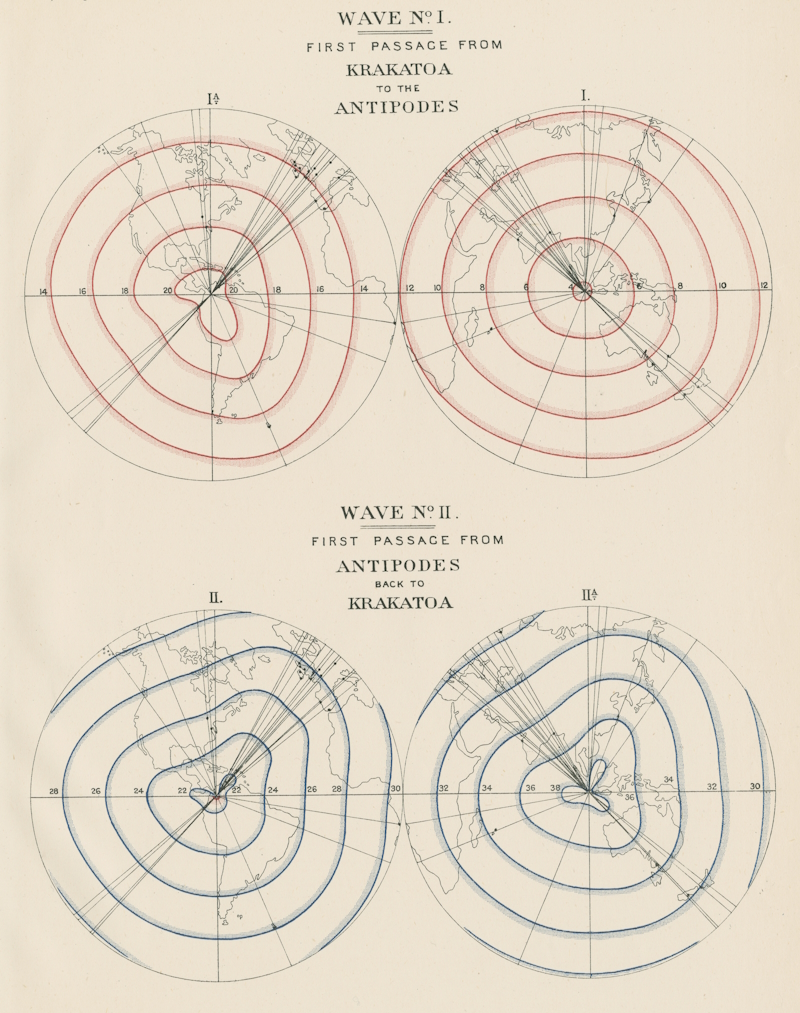 Four figures showing the ocean tracks of the first and second tsunami waves generated by the eruption of Krakatoa, published in the Report of the Krakatoa Committee of the Royal Society
Four figures showing the ocean tracks of the first and second tsunami waves generated by the eruption of Krakatoa, published in the Report of the Krakatoa Committee of the Royal Society
Krakatoa brought devastation but, as is common with natural disasters and pandemics, also resulted in a collaborative worldwide human effort to document and understand the catastrophe, advancing scientific knowledge in the process.
The recent volcanic activity in Grindavík, Iceland, is a reminder of the Earth's natural subterranean geography, with its dramatic eruption causing fissures to appear and spewing curtains of lava into the air for hundreds of metres. Although not the same magnitude as Krakatoa, the sense of wonderment it inspires is similar. Today we have much more sophisticated methods of viewing and sharing the phenomena, in real time – drone footage posted to social media, images captured on smart phones, live webcams for anyone to see – but ultimately these are simply faster methods of conveying the same sort of information shared by observers of Krakatoa over 140 years ago.
To find out more about the scientific efforts to document the eruption of Krakatoa, you can visit The 1883 Eruption of Krakatoa — Google Arts & Culture, read The eruption of Krakatoa and subsequent phenomena, and discover MS/516, ‘Letters to the Royal Society's Krakatoa Committee 1884-1888’, the cataloguing of which is currently in progress.

